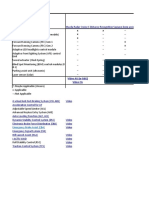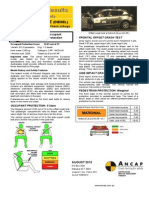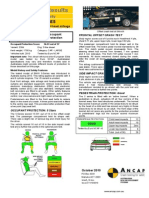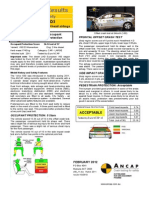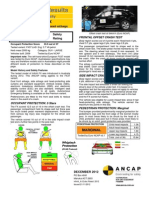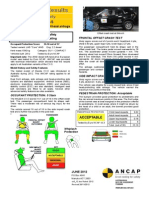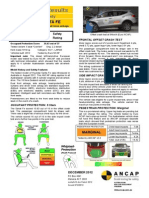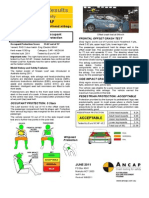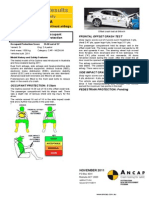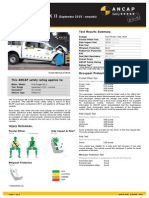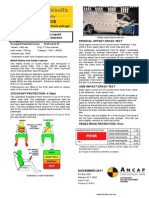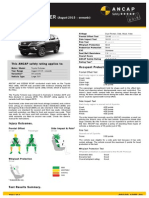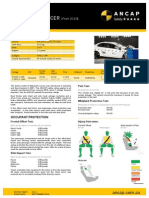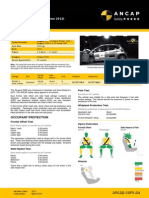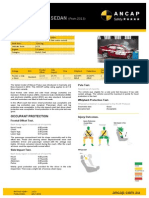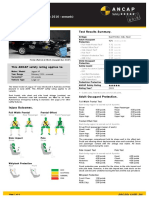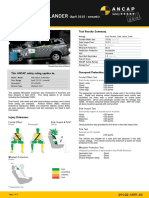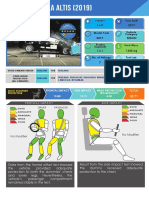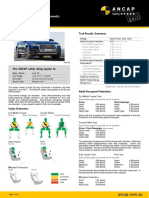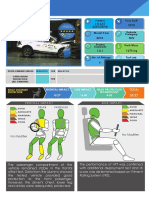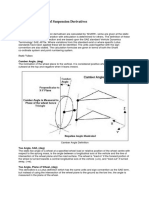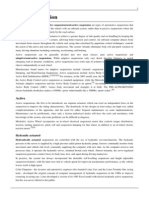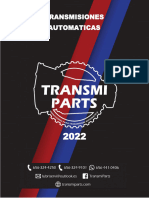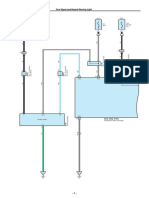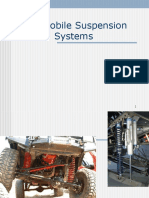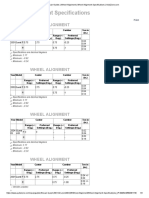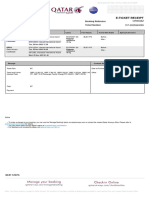Mazda Bt-50 Ancap
Mazda Bt-50 Ancap
Uploaded by
carbasemyCopyright:
Available Formats
Mazda Bt-50 Ancap
Mazda Bt-50 Ancap
Uploaded by
carbasemyCopyright
Available Formats
Share this document
Did you find this document useful?
Is this content inappropriate?
Copyright:
Available Formats
Mazda Bt-50 Ancap
Mazda Bt-50 Ancap
Uploaded by
carbasemyCopyright:
Available Formats
NOVEMBER 2011
PO Box 4041
Manuka ACT 2603
bt50_11.doc
Issued 24/11/2011
Crash Test Results
New Car Safety
MAZDA BT50
From Oct 2011 Front+side+head airbags
Occupant
Protection
Occupant Protection Score 35.72 out of 37
Variant: Double cab, 4x4, Eng: 2.2 diesel
Kerb mass 2090 kg Category: UTILITY
Vehicles built: 2011 Tested by Euro NCAP
Important note: The RHD 2.2 diesel Ford Ranger was
tested by Euro NCAP. ANCAP was provided with technical
information which showed that all Australasian variants of
the BT50 have comparable occupant protection to the
tested Ford Ranger.
Model History and Safety Features
This Mazda BT50 was introduced in Australia and New
Zealand in October 2011. This ANCAP 5-star rating applies
to all BT50 variants (all bodystyles, engines, 4X4 and 4X2)
sold in Australia and New Zealand.
Dual front airbags, head-protecting side curtains, antilock
brakes (ABS), electronic brakeforce distribution (EBD) and
electronic stability control (ESC) are standard. Side thorax
airbags are also standard except for single cabs with three
front seats (bench seats). These variants, with 4 airbags,
retain a 5-star rating. Intelligent seat belt reminders are
fitted to both front seats of most variants. However single
cab variants with three front seats only have a driver seat
belt reminder. The overall score for these reduces to 34.72
but they retain a 5-star rating.
OCCUPANT PROTECTION: 5 Stars
The vehicle scored 15.72 out of 16 in the offset crash test.
The passenger compartment held its shape well. There
was a slight risk of serious chest injury for the driver. The
vehicle scored 16 out of 16 in the side impact crash test
and a further two points in the pole test.
FRONTAL OFFSET CRASH TEST
Body region scores out of 4 points each: Head/neck 4 pts,
chest 3.72 pts, upper legs 4 pts, lower legs 4 pts.
The passenger compartment held its shape well in the
offset crash test. The accelerator pedal moved rearwards
by 58 mm and upwards 7 mm. The steering wheel hub
moved 40mm forward, 2mm downward and 7 mm
sideways. The front ("A") pillar moved 2mm rearwards. All
doors remained closed during the crash. After the crash the
all doors could be opened with normal effort.
The airbag cushioned the head of the driver and contact
was stable. The vehicle tested by Euro NCAP had a driver
knee airbag that is not available for Australasian models.
However Ford/Mazda provided technical information to
ANCAP which demonstrated that the Australasian models
of the Ranger and BT50 have comparable upper leg
protection to the European model. The passenger's head
was cushioned by the airbag.
SIDE IMPACT CRASH TEST
Body region scores out of 4 points each: Head 4 pts, chest
4 pts, abdomen 4 pts, pelvis 4 pts.
The side impact test simulates a small car striking the
driver's door of the vehicle under test. It is based on a
regulation test but the regulation does not apply to vehicles
with a high seat height like the Ranger/BT50. Experience
shows that such vehicles can be expected to perform well
in this test and the Ranger/BT50 scored full marks.
The vehicle was eligible for a pole impact test, since it had
head-protecting side airbags. The vehicle earned the
maximum two points in this test.
PEDESTRIAN PROTECTION: Not tested
The BT50 has design differences which mean that the
Ranger pedestrian protection tests do not apply to this
model.
April 2007
PO Box 1555
Canberra ACT
Australia 2601
issued
Offset crash test at 64km/h (Ford Ranger)
www.ancap.com.au
TECHNICAL DATA - MAZDA BT50 - From Oct 2011
INJURY MEASUREMENTS
Body region
Offset Crash Test at 64km/h
(v5.1)
Side Impact Crash
Test at 50km/h
(v5.1)
Driver Passenger Driver
Head HIC 403 297 18
Acceleration (g for 3ms) 52.8 46.7 17.7
Neck - Shear (kN) 0.62 0.36 -
Tension (kN) 1.51 1.03 -
Extension (Nm) 15.9 13.8 -
Chest Accln (g for 3ms) - - -
Compression (mm) 23.94 21.11 11.25
Viscous criterion (m/s) 0.11 0.12 0.06
Abdomen - Force (kN) - - 0.240
Pelvis - Force (kN) - - 0.670
Upper legs Force (kN) Left 0.66 0.10
Right 0.96 0.10
Knee displ (mm) Left 0.80 0.10
Right 0.90 0.20
Lower legs Force (kN) Left 1.72 0.72
Right 1.91 1.68
Index (Upper/Low) Left 0.27 /0.25 0.28 /0.17
Right 0.28 /0.24 0.34/0.31
Bonus points (maximum 5)
Pole Test: 2 pts
Seat belt reminders: 2 (except single cabs with three front seats: 1 point)
Modifiers - deductions from offset test scores
Head No deduction
Chest No deduction
Upper leg No deduction
Lower leg No deduction
Foot score Score 4 points
Modifiers - deductions from side impact test scores
Chest No deduction
Safety features
These specifications are subject to change. Please check with manufacturer for the latest specifications.
Driver airbag S Antilock (ABS) brakes / Electronic brake
distribution / Brake Assist
S/S/S
Passenger front airbag S Electronic stability control (ESC, VSC, DSC,
ESP, VSA)
S#
Side airbags, front seats - chest protection S* 3 point seat belts for all seats S
Side airbags, front seats - head protection S Whiplash protection Pending
Side airbags, rear seats - head protection S Intelligent seat belt reminder - driver S
Driver knee airbag X ! Intelligent seat belt reminder - front
passenger
S*
Seat belt pretensioners (Front/Rear outboard) S/X Intelligent seat belt reminder - rear seats X
Key: ! = Fitted to vehicle that was crash tested (where not standard) * Not available on single cabs with three front seats
S = standard on all variants
O = optional on base variant. May be standard on higher variant
V= not available on base variant but standard or optional on higher variants
X = not available on any variant
# ESC required by ANCAP for 5 star rating from 2008
You might also like
- Transport Economics - Kenneth Button - 4, 2022 - Edward Elgar Publishing - 9781786435682 - Anna's ArchiveDocument589 pagesTransport Economics - Kenneth Button - 4, 2022 - Edward Elgar Publishing - 9781786435682 - Anna's ArchivePeter Okitoi100% (1)
- CARFAX Vehicle History Report PDFDocument4 pagesCARFAX Vehicle History Report PDFcarfaxNo ratings yet
- Mazda SkyActiv OBD-II Calc (FORScan) v6.25Document222 pagesMazda SkyActiv OBD-II Calc (FORScan) v6.25XuNo ratings yet
- Ford 350 Super Duty 2018 PDFDocument56 pagesFord 350 Super Duty 2018 PDFAdalid Ortiz RodriguezNo ratings yet
- Chevy Differentials: How to Rebuild the 10- and 12-BoltFrom EverandChevy Differentials: How to Rebuild the 10- and 12-BoltRating: 5 out of 5 stars5/5 (17)
- 2020 Toyota Hilux ASEAN NCAP Crash Test ReportDocument4 pages2020 Toyota Hilux ASEAN NCAP Crash Test ReportcarbasemyNo ratings yet
- Renault Megane ANCAP PDFDocument2 pagesRenault Megane ANCAP PDFcarbasemyNo ratings yet
- Crash Test Results: Honda CR-ZDocument2 pagesCrash Test Results: Honda CR-ZcarbasemyNo ratings yet
- Crash Test Results: New Car SafetyDocument2 pagesCrash Test Results: New Car SafetycarbasemyNo ratings yet
- BMW 5 Series AncapDocument2 pagesBMW 5 Series AncapcarbasemyNo ratings yet
- Volvo S60 ANCAP PDFDocument2 pagesVolvo S60 ANCAP PDFcarbasemyNo ratings yet
- Crash Test Results: Infiniti FXDocument2 pagesCrash Test Results: Infiniti FXcarbasemyNo ratings yet
- Crash Test Results: Mazda Cx-5Document2 pagesCrash Test Results: Mazda Cx-5carbasemyNo ratings yet
- Volkswagen Jetta ANCAP PDFDocument2 pagesVolkswagen Jetta ANCAP PDFcarbasemyNo ratings yet
- Mercedes C-Class Coupe ANCAPDocument2 pagesMercedes C-Class Coupe ANCAPcarbasemyNo ratings yet
- Audi A6 AncapDocument2 pagesAudi A6 AncapcarbasemyNo ratings yet
- Crash Test Results: HYUNDAI Ix35Document2 pagesCrash Test Results: HYUNDAI Ix35carbasemyNo ratings yet
- Volvo V60 ANCAP PDFDocument2 pagesVolvo V60 ANCAP PDFcarbasemyNo ratings yet
- Hyundai Santa Fe ANCAPDocument2 pagesHyundai Santa Fe ANCAPcarbasemyNo ratings yet
- Crash Test Results: New Car SafetyDocument2 pagesCrash Test Results: New Car SafetycarbasemyNo ratings yet
- Alfa Romeo Giulietta ANCAPDocument2 pagesAlfa Romeo Giulietta ANCAPcarbasemyNo ratings yet
- Chevrolet Colorado ANCAP PDFDocument2 pagesChevrolet Colorado ANCAP PDFcarbasemyNo ratings yet
- Honda Jazz ANCAPDocument2 pagesHonda Jazz ANCAPcarbasemyNo ratings yet
- Audi q3 AncapDocument2 pagesAudi q3 AncapcarbasemyNo ratings yet
- Crash Test Results: Nissan LeafDocument2 pagesCrash Test Results: Nissan LeafcarbasemyNo ratings yet
- Chevrolet Sonic ANCAPDocument3 pagesChevrolet Sonic ANCAPcarbasemyNo ratings yet
- Crash Test Results: Kia OptimaDocument2 pagesCrash Test Results: Kia OptimacarbasemyNo ratings yet
- Citroen DS4 ANCAP PDFDocument2 pagesCitroen DS4 ANCAP PDFcarbasemyNo ratings yet
- Toyota Camry ANCAP PDFDocument2 pagesToyota Camry ANCAP PDFcarbasemyNo ratings yet
- Toyota Previa ANCAP PDFDocument2 pagesToyota Previa ANCAP PDFcarbasemy0% (1)
- Ford Ranger ANCAP PDFDocument3 pagesFord Ranger ANCAP PDFcarbasemyNo ratings yet
- Nissan Navara ANCAPDocument2 pagesNissan Navara ANCAPcarbasemyNo ratings yet
- Honda CR-V AncapDocument3 pagesHonda CR-V AncapcarbasemyNo ratings yet
- Toyota Hiace ANCAP PDFDocument2 pagesToyota Hiace ANCAP PDFcarbasemyNo ratings yet
- Toyota Fortuner ANCAP PDFDocument3 pagesToyota Fortuner ANCAP PDFcarbasemyNo ratings yet
- Ford Kuga AncapDocument3 pagesFord Kuga AncapcarbasemyNo ratings yet
- Toyota 86 ANCAP PDFDocument3 pagesToyota 86 ANCAP PDFcarbasemyNo ratings yet
- Crash Test Results: Toyota CamryDocument2 pagesCrash Test Results: Toyota CamryMohan ReddyNo ratings yet
- Mitsubishi Lancer ANCAPDocument3 pagesMitsubishi Lancer ANCAPcarbasemy100% (2)
- Ford Everest ANCAP PDFDocument3 pagesFord Everest ANCAP PDFcarbasemy0% (1)
- Peugeot 2008 ANCAPDocument3 pagesPeugeot 2008 ANCAPcarbasemyNo ratings yet
- Mitsubishi Mirage ANCAPDocument3 pagesMitsubishi Mirage ANCAPcarbasemyNo ratings yet
- Volkswagen Golf Mk7 ANCAP PDFDocument3 pagesVolkswagen Golf Mk7 ANCAP PDFcarbasemyNo ratings yet
- Mitsubishi Pajero ANCAPDocument3 pagesMitsubishi Pajero ANCAPcarbasemyNo ratings yet
- Mitsubishi Triton ANCAP PDFDocument3 pagesMitsubishi Triton ANCAP PDFcarbasemyNo ratings yet
- Honda Odyssey ANCAPDocument3 pagesHonda Odyssey ANCAPcarbasemyNo ratings yet
- Proton Exora: ANCAP Safety RatingDocument3 pagesProton Exora: ANCAP Safety RatingMohd IzarulNo ratings yet
- Nissan Navara ANCAP PDFDocument3 pagesNissan Navara ANCAP PDFcarbasemyNo ratings yet
- Subaru WRX AncapDocument3 pagesSubaru WRX AncapcarbasemyNo ratings yet
- Proton Preve ANCAP Crash Test ResultsDocument3 pagesProton Preve ANCAP Crash Test ResultsPaul TanNo ratings yet
- BMW 2 Active Tourer ANCAP PDFDocument3 pagesBMW 2 Active Tourer ANCAP PDFcarbasemyNo ratings yet
- Citroen C4 Picasso ANCAPDocument3 pagesCitroen C4 Picasso ANCAPcarbasemyNo ratings yet
- Range Rover ANCAPDocument3 pagesRange Rover ANCAPcarbasemyNo ratings yet
- Nissan Sylphy ANCAPDocument3 pagesNissan Sylphy ANCAPcarbasemyNo ratings yet
- Jaguar XF ANCAP PDFDocument4 pagesJaguar XF ANCAP PDFcarbasemyNo ratings yet
- Mondeo ANCAP PDFDocument3 pagesMondeo ANCAP PDFcarbasemyNo ratings yet
- Mitsubishi Outlander ANCAP PDFDocument3 pagesMitsubishi Outlander ANCAP PDFcarbasemyNo ratings yet
- CRV PDFDocument3 pagesCRV PDFazsigncNo ratings yet
- Mazda CX-3 ANCAP PDFDocument3 pagesMazda CX-3 ANCAP PDFcarbasemyNo ratings yet
- Introduction to Basics of Car Ownership Auto Mechanics FundamentalsFrom EverandIntroduction to Basics of Car Ownership Auto Mechanics FundamentalsNo ratings yet
- Caring for your scooter: How to maintain & service your 49cc to 125cc twist & go scooterFrom EverandCaring for your scooter: How to maintain & service your 49cc to 125cc twist & go scooterNo ratings yet
- Master the T-CLOCS Pre-Ride Safety Inspection in 15 MinutesFrom EverandMaster the T-CLOCS Pre-Ride Safety Inspection in 15 MinutesNo ratings yet
- Basic MOT Checks: DVSA Safe Driving for Life SeriesFrom EverandBasic MOT Checks: DVSA Safe Driving for Life SeriesNo ratings yet
- The Dual Wheel Journey Motorcycle Terms Dictionary and Phrasebook: DWJ Dictionary, #2From EverandThe Dual Wheel Journey Motorcycle Terms Dictionary and Phrasebook: DWJ Dictionary, #2No ratings yet
- 2020 Isuzu D-Max Euro NCAPDocument17 pages2020 Isuzu D-Max Euro NCAPcarbasemyNo ratings yet
- New Peugeot 2008 Euro NCAP Crash TestDocument15 pagesNew Peugeot 2008 Euro NCAP Crash TestcarbasemyNo ratings yet
- 2022 Proton Iriz and Persona Facelift ASEAN NCAP Crash Test ReportDocument4 pages2022 Proton Iriz and Persona Facelift ASEAN NCAP Crash Test ReportcarbasemyNo ratings yet
- W247 Mercedes-Benz B-Class Euro NCAP Crash Test ResultDocument14 pagesW247 Mercedes-Benz B-Class Euro NCAP Crash Test ResultcarbasemyNo ratings yet
- 2020 Honda City ASEAN NCAP Crash Test ReportDocument4 pages2020 Honda City ASEAN NCAP Crash Test ReportcarbasemyNo ratings yet
- Nissan Magnite ASEAN NCAPDocument4 pagesNissan Magnite ASEAN NCAPcarbasemyNo ratings yet
- Euroncap 2016 Audi q2 DatasheetDocument11 pagesEuroncap 2016 Audi q2 DatasheetcarbasemyNo ratings yet
- Proton X50 ASEAN NCAP Digital ReportDocument4 pagesProton X50 ASEAN NCAP Digital ReportcarbasemyNo ratings yet
- 2019 Toyota Corolla Altis ASEAN NCAP Crash Test ReportDocument4 pages2019 Toyota Corolla Altis ASEAN NCAP Crash Test ReportcarbasemyNo ratings yet
- Audi q2 AncapDocument4 pagesAudi q2 Ancapcarbasemy100% (1)
- Toyota Rush 2018 ASEAN NCAPDocument4 pagesToyota Rush 2018 ASEAN NCAPcarbasemyNo ratings yet
- Audi q5 AncapDocument4 pagesAudi q5 AncapcarbasemyNo ratings yet
- BMW X1 / X2: Test ResultsDocument11 pagesBMW X1 / X2: Test ResultscarbasemyNo ratings yet
- Kia Picanto (With AEB) Euro NCAP ReportDocument11 pagesKia Picanto (With AEB) Euro NCAP ReportcarbasemyNo ratings yet
- 2019 Toyota Camry ANCAP ReportDocument3 pages2019 Toyota Camry ANCAP ReportcarbasemyNo ratings yet
- G01 BMW X3 AncapDocument4 pagesG01 BMW X3 AncapcarbasemyNo ratings yet
- Proton x70 ASEAN NCAPDocument4 pagesProton x70 ASEAN NCAPcarbasemyNo ratings yet
- RFiD TouchnGo Malaysia FAQDocument10 pagesRFiD TouchnGo Malaysia FAQcarbasemyNo ratings yet
- Perodua Aruz ASEAN NCAPDocument4 pagesPerodua Aruz ASEAN NCAPcarbasemyNo ratings yet
- Toyota Rush 2018 ASEAN NCAPDocument4 pagesToyota Rush 2018 ASEAN NCAPcarbasemyNo ratings yet
- Euroncap 2017 Kia Stinger DatasheetDocument11 pagesEuroncap 2017 Kia Stinger DatasheetcarbasemyNo ratings yet
- Toyota C-HR ASEAN NCAPDocument4 pagesToyota C-HR ASEAN NCAPcarbasemyNo ratings yet
- Euroncap 2017 Land Rover Discovery DatasheetDocument11 pagesEuroncap 2017 Land Rover Discovery DatasheetcarbasemyNo ratings yet
- Mitsubishi Xpander ASEAN NCAPDocument4 pagesMitsubishi Xpander ASEAN NCAPcarbasemyNo ratings yet
- Ancap BMW x2Document6 pagesAncap BMW x2carbasemyNo ratings yet
- Noida 6100 Till HighDocument45 pagesNoida 6100 Till Highlalitchauhan71No ratings yet
- Delphi Car Apps PDFDocument3,242 pagesDelphi Car Apps PDFClaudiu MorarNo ratings yet
- Theory Definition of Suspension Derivatives: Camber Angle, (Deg)Document70 pagesTheory Definition of Suspension Derivatives: Camber Angle, (Deg)Danilo RojasNo ratings yet
- Active SuspensionDocument5 pagesActive SuspensionPrasad BillahalliNo ratings yet
- BSP France: BSP France Fac-Similé Reçu de Transport Emission AutomatiqueDocument6 pagesBSP France: BSP France Fac-Similé Reçu de Transport Emission Automatiqueadnan altawilyNo ratings yet
- Car Setup and Troubleshooting GuideDocument3 pagesCar Setup and Troubleshooting GuideAjit KumarNo ratings yet
- Cjenovnik Corolla Sedan: Hibrid - Benzinski/elektro - EURO 6Document2 pagesCjenovnik Corolla Sedan: Hibrid - Benzinski/elektro - EURO 6dannyboy001No ratings yet
- Catalago Transmiparts 2022Document98 pagesCatalago Transmiparts 2022iREXERNo ratings yet
- Lexus Specifications GS 2016 2016-09-23 PDFDocument9 pagesLexus Specifications GS 2016 2016-09-23 PDFTetsunari KodaNo ratings yet
- Lista Cambio Transmissao 13Document1 pageLista Cambio Transmissao 13MamuteNo ratings yet
- Euroncap 2015 Mercedes Benz GLC DatasheetDocument12 pagesEuroncap 2015 Mercedes Benz GLC DatasheetVlad LepadatuNo ratings yet
- Subaru Outback 2023 Quick Reference GuideDocument24 pagesSubaru Outback 2023 Quick Reference GuideOlegas LesinasNo ratings yet
- Turn Signal and Hazard Warning Light: (BAT) (ACC) (BAT)Document6 pagesTurn Signal and Hazard Warning Light: (BAT) (ACC) (BAT)CLC 18C4No ratings yet
- Suspension SystemsDocument118 pagesSuspension SystemsEZHILARASAN R100% (1)
- D4B804A2FDD-Running Gear Axles SteeringDocument373 pagesD4B804A2FDD-Running Gear Axles SteeringAnonymous W7u3qzaO0PNo ratings yet
- Body Panels of Unibody: UME 502 Automobile EngineeringDocument27 pagesBody Panels of Unibody: UME 502 Automobile EngineeringARYAN PIRTANo ratings yet
- Abs and VSC: 2005 PRIUS (EWD599U)Document13 pagesAbs and VSC: 2005 PRIUS (EWD599U)Sherman KillerNo ratings yet
- Producto-Amortiguadores Fred PeugDocument52 pagesProducto-Amortiguadores Fred PeugfrederickNo ratings yet
- Motto Price List May 2022Document59 pagesMotto Price List May 2022Shekh SameenNo ratings yet
- Merge 0005Document55 pagesMerge 0005Hamid JafarimaramNo ratings yet
- Repair Guides - Wheel Alignment - Wheel Alignment SpecificationsDocument3 pagesRepair Guides - Wheel Alignment - Wheel Alignment Specificationscarlos zeballosNo ratings yet
- Strattec 2016 Comprehensive CatalogDocument188 pagesStrattec 2016 Comprehensive CatalogDaniel TorresNo ratings yet
- E TicketDocument3 pagesE Ticketakhyar.vindicatedNo ratings yet
- Notices of DefectDocument333 pagesNotices of DefectRavelco do BrasilNo ratings yet
- Electric Solar Vehicle Championship (ESVC) : Suspension System (Cushions For The Passanger)Document26 pagesElectric Solar Vehicle Championship (ESVC) : Suspension System (Cushions For The Passanger)Ishwarjit SinghNo ratings yet
- Fuel Savings CalculatorDocument1 pageFuel Savings CalculatorKevin RobertNo ratings yet


